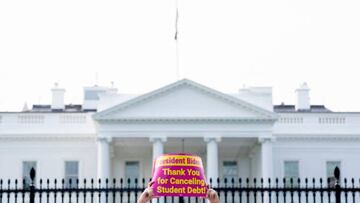Which states are taxing student loan forgiveness?
While student loan forgiveness received from the Biden-Harris debt relief won’t be taxed federally, some that benefit could be liable for state taxes.

Keeping one of his campaign promises President Biden announced in August that his administration would cancel up to $20,000 in federal student loan debt. It finally came after nearly two years from his inauguration with the delay due in part to working out the broad-based debt forgiveness.
Student loan debt in the United States has ballooned over the past two decades reaching over $1.7 trillion in total. The average federal borrower has over $37,000 in student loan debt. Thus the measure came as welcome news but for some they will have to consider the tax implications. While the financial relief for federal student loan borrowers won’t be taxed federally nor in most states thanks to the American Rescue Plan, that won’t be the case in at least four states, with another three considering whether to do so.
Also see:
- Student loan cancellation: Who qualifies and what does one need to do to have the debt cancelled?
- Can student loan forgiveness affect your credit score?
- Student loan forgiveness: Four important dates to keep in mind
- How to get refunds if you made student loan payments during covid-19
- Student loan forgiveness application: How to apply online using the new Beta version
States that will tax student loan debt forgiveness
Under the American Rescue Plan Act the forgiveness of student loan debt between 2021 and 2025 does not count toward federal taxable income. Not all states tax income, but the vast majority of the states that tax income conform with the federal definition of taxable income.
However, currently, Indiana, Minnesota, Mississippi and North Carolina will treat any amount of student loans that is forgiven as earned income. Three more are still in the process of deciding whether to do so at this time including Arkansas, California and Wisconsin.
How much state tax will beneficiaries of student loan debt forgiveness have to pay?
There are a handful of factors that will decide how much a borrower will have to pay in tax for the discharge of indebtedness. Recipients of the debt forgiveness will need to add the amount that they receive to their other sources of taxable income and see which tax bracket they fall into for their state to determine the rate at which they will be taxed.
Analysis by the Tax Foundation, assuming you are eligible for $10,000 of loan forgiveness, the maximum for those with income under $125,000 a year, in Mississippi would have a to pay $500 on that source of income. Double that amount for Pell Grant recipients that qualify for $20,000 in debt forgiveness.
Paying tax on student loan debt forgiveness shouldn’t deter recipients
Depending on the state you live in, income tax rate could be flat, like Indiana and North Carolina, so that additional income will not put you into a higher tax bracket. However, Mississippi has a progressive rate where income starting at three percent for income above $4,000 and goes up by increments to a maximum of five percent for taxable income over $10,000.
Income is also taxed progressively in Minnesota, along with Arkansas, West Virginia and Wisconsin. However, the additional amount of tax liability from receiving federal student loan forgiveness would in a majority of cases be more than offset by the debt reduction.
“Even if you’re taxed at a higher rate because you got extra forgiveness, that could potentially yield a lifetime’s worth of not having to worry about your student loan,” Jacob Channel, a senior economist at LendingTree, told CNBC. “For the most part, the benefit you’ll get from having 10 to $20,000 worth of your student loan debt forgiven will probably outweigh the tax burden.”
Important dates for the federal student loan debt forgiveness
Those who are eligible for student loan debt relief will need to keep four important dates in mind. Sometime in October a simple application will be available and those that could have their student loan debt reduced to zero through the debt forgiveness and don’t want to make further payments on their loan will want to get that in by 15 November.
That’s because the student loan moratorium ends 31 December and the Education Department says it will take up to six weeks from the time the application is submitted until the debt is discharged. The final date, 31 December 2023, will be the final date to apply for federal student loan debt forgiveness.






